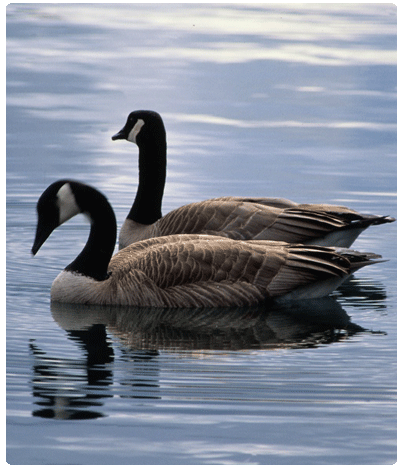 Avian influenza (AI) is a serious and harmful disease found primarily in birds but it also has been detected in mammals. Bird watchers, rehabilitators, bird banders, and hunters need to be careful when in contact with wild birds. This webpage outlines steps to report possible cases of AI to wildlife managers. Read a fact sheet on AI.
Avian influenza (AI) is a serious and harmful disease found primarily in birds but it also has been detected in mammals. Bird watchers, rehabilitators, bird banders, and hunters need to be careful when in contact with wild birds. This webpage outlines steps to report possible cases of AI to wildlife managers. Read a fact sheet on AI.
Risks of Avian Influenza
Different strains of avian influenza (AI) occur naturally in wild birds in North America. Highly pathogenic avian influenza (HPAI) refers to strains that are especially fatal to domestic poultry. It is unknown how these viruses will impact wild bird populations.
HPAI’s risk to the general public is low according to the Centers for Disease Control and Prevention. To date, the CDC has reported several human cases of HPAI among individuals working with livestock/poultry. There continues to be no evidence of human infection in Vermont.
Reporting Possible Cases of Wildlife Diseases
Highly Pathogenic Avian Influenza (HPAI) has now been detected in a variety of wild birds in Vermont, including bald eagles, red tailed hawks, Canada geese, wood ducks, mallards, black ducks, and turkey vultures. Infected birds have been found in all regions of Vermont.
HPAI has also been detected in domestic fowl and one mammal species in Vermont.
Vermont Fish & Wildlife officials are continuing to monitor the presence of HPAI in Vermont’s wild birds. The public can help by using the guidelines below to distinguish between natural expected bird mortality versus something that may be more serious.
Alert the department (email fwinformation@vermont.gov or call 802-828-1000) if you see certain conditions, specifically:
- Hawks or owls: 2 or more found sick or dead (except along the side of the roadways---at roadway locations, vehicle strikes are the most probable cause of death)
- Any loons or eagles found sick or dead
- Crows, jays, or ravens: 5 or more found sick or dead in the same location
- Songbirds: 5 or more found sick or dead birds in the same visual area
- Terns: more than 2 found sick or dead
- Waterfowl: 5 or more found sick or dead in the same area within 1-2 days
- Wild turkeys: 3 or more found sick or dead
- These guidelines will certainly change as time goes on. Please check this webpage for up-to-date guidance before calling. To conserve laboratory resources only a select group of individuals will be tested.
Considerations For Bird Feeding
The department is recommending caution when using bird feeders during the regular bird feeding season of December 1 through April 1. Bird feeders should be cleaned following these recommendations. Any possible cases meeting the criteria above should be reported to wildlife officials who will advise the caller whether to take down feeders. Additionally, feeding stations should be placed far away from any domestic birds on the property to minimize the risk of transmission from wild to domestic flocks.
More generally, there are some diseases that feeding birds may encounter in your backyard under any circumstances. Learn more about these commonly occurring diseases, (salmonellosis, mycoplasma, trichomoniasis, and aspergillosis) by visiting Wild Futures Program Disease Fact Sheets. To help prevent these diseases under regular circumstances, we recommend following these guidelines for keeping bird feeders clean and disease free.
Considerations for Rehabilitators and Bird Banders
Wildlife rehabilitators and bird banders who handle wild birds are on the frontline of avian influenza detection. Fish & Wildlife officials appreciate the cooperation of anyone who encounters wild birds.
Biosecurity is Key
The department recommends rehabilitation facilities have an isolation location to monitor new arrivals for diseases because of the potential effect of AI on an entire facility. Accepting new birds has the potential to put all captive birds at risk.
The department is making this recommendation to protect the long-term health of your programs. Biosecurity is the key to keeping AI out of your facilities.
AI is found in multiple species, not just waterfowl. If new birds are accepted into rehabilitation without an isolation facility, it could put all your birds at risk of the disease. If the disease is found on a farm or facility, the treatment is to depopulate the entire building of birds. The buildings will then receive various treatments to eliminate the virus.
An isolation facility can prevent transmission of any pathogen to other susceptible species. Admission to such a facility may include testing at entry and exit.
It is recommended new poultry being brought to farms be quarantined in an isolation facility for 30 days. The department suggests similarly for wild birds being brought into isolation prior to rehabilitation. Note that any new bird(s) accepted into the isolation facility could expose other birds previously in isolation, resetting the quarantine.
Best Practices for Handling Birds
Bird rehabilitators, banders, and others who handle wild birds should follow necessary precautions to prevent the spread of AI and other diseases among birds. We recommend that those handling wild birds:
- Implement hygiene procedures and practices including cleaning and disinfecting equipment, holding devices (e.g., bird bags), and clothes worn during banding
- Follow personal hygiene practices including hand cleaning or, when possible, wearing gloves
- Do not eat, drink, or smoke while handling wild birds and work in a well-ventilated environment
- Be particularly diligent if you plan to have contact with domestic poultry; should you become ill, inform your doctor of your contact with wild birds
Following these guidelines will help the department make the best use of their resources and safeguard wildlife health.
For More Information
